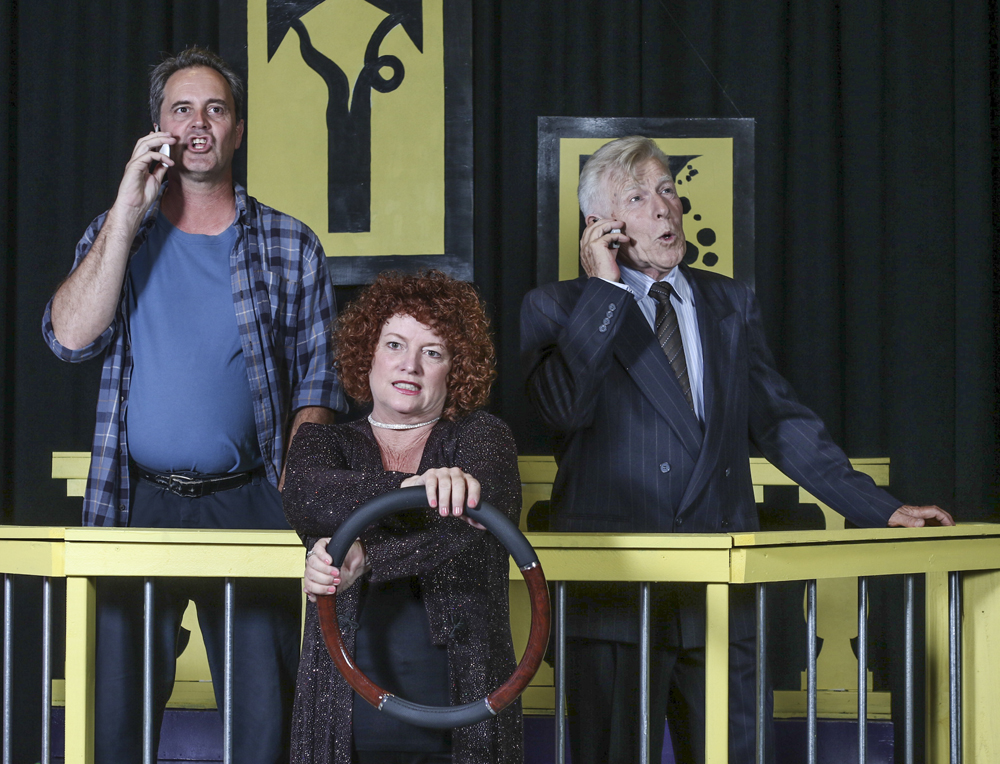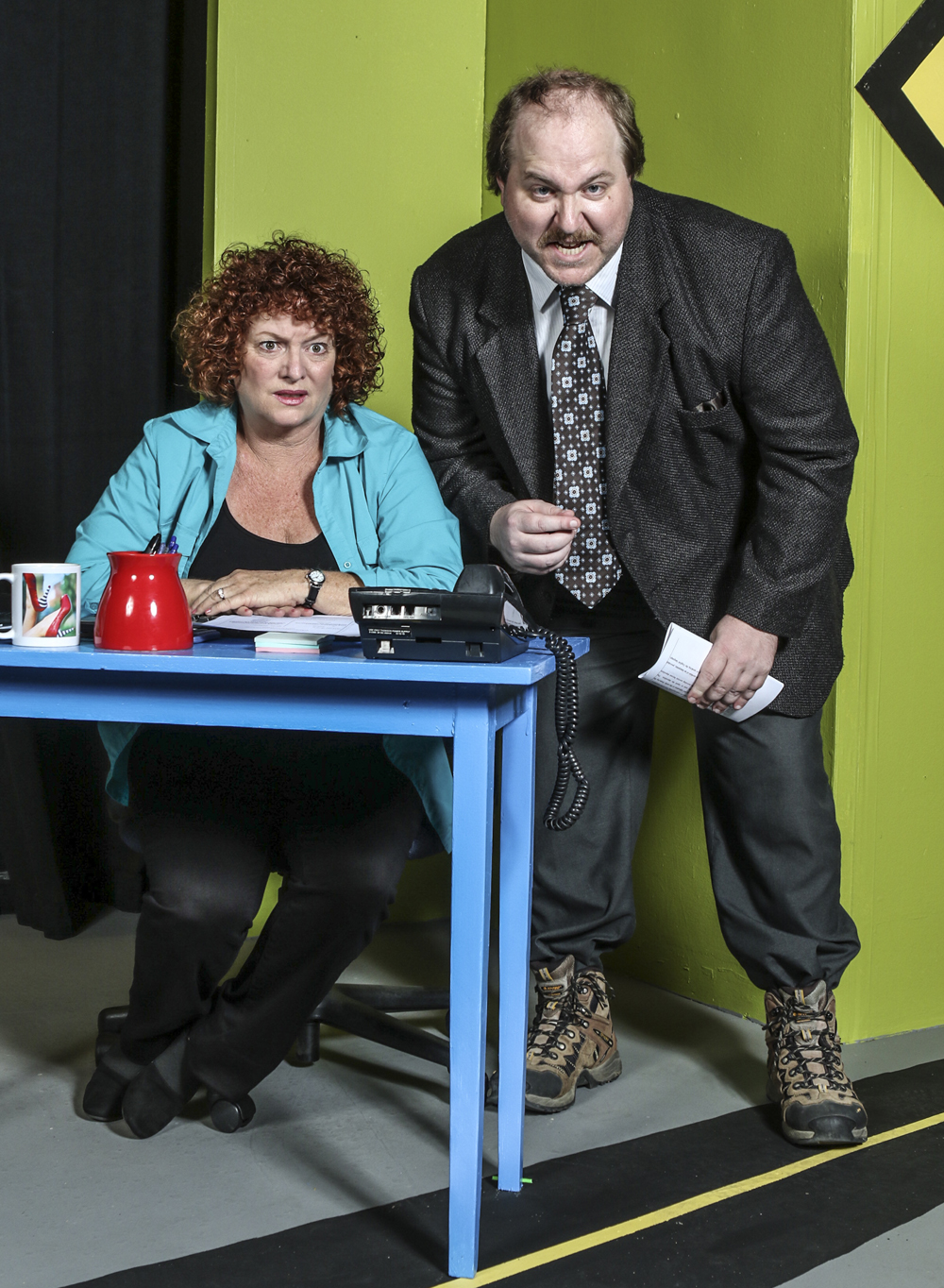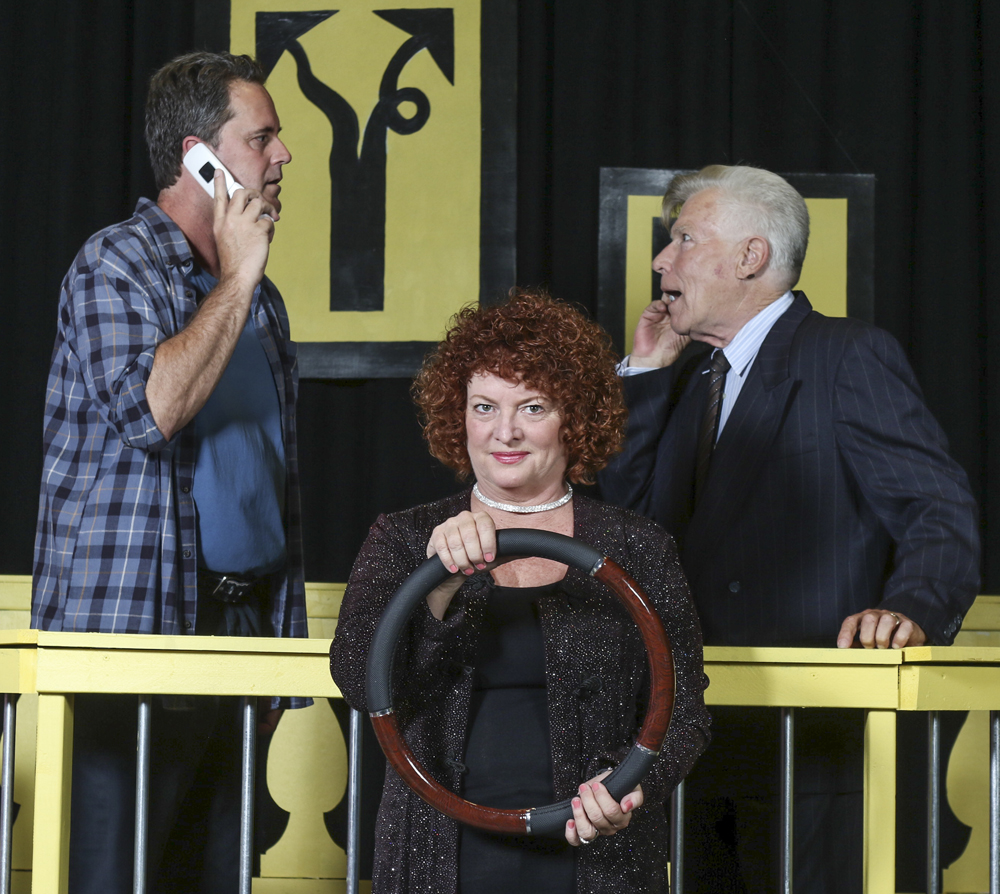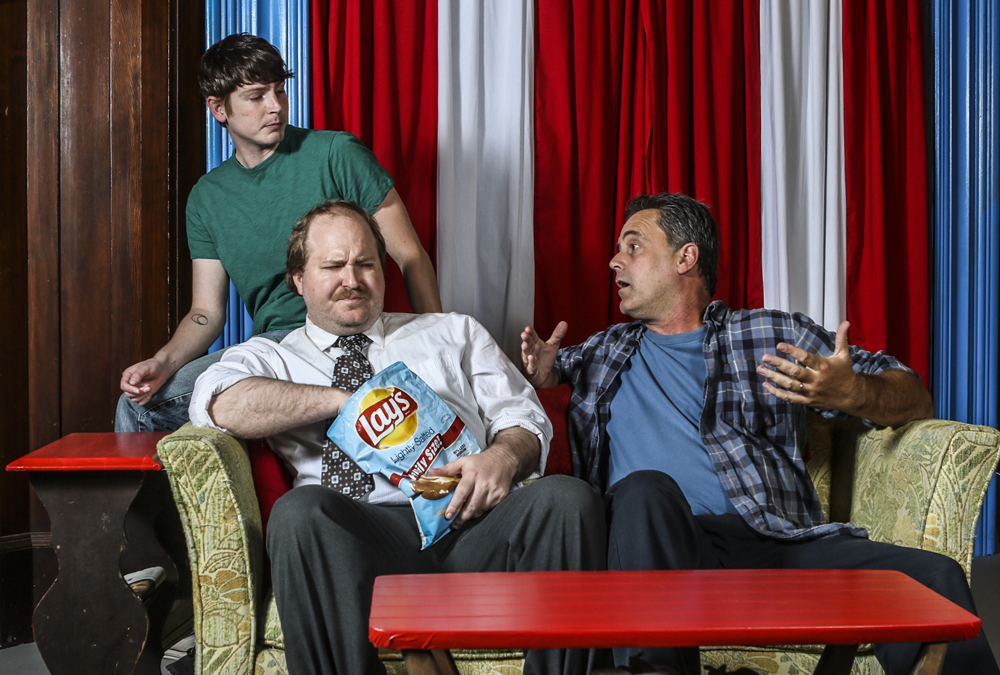11 minutes reading time
(2201 words)
Review: Becky’s New Car

Theatre
Review
Becky’s New Car
The Santa Paula Theatre Company is currently offering a delightful production of Steven Dietz’s Becky’s New Car, an easy-going farce written for a tight ensemble.
The play is set in summer “in a town very much like Seattle …” and is about a fairly normal middle-class woman, Becky, in a conventional ho-hum marriage. Becky works in an auto dealership while her husband, Joe, runs a roofing business. One day a somewhat disconnected, eccentric billionaire, Walter Flood, enters her office and through a misunderstanding offers Becky the possibility of a somewhat parallel existence.
(l)Scott Blanchard, Cynthia Killion, and Ronald Rezac in Steven Dietz' hilarious comedy BECKY'S NEW CAR playing through October 1 at the Santa Paula Theater Center.
 Theatre
TheatreReview
Becky’s New Car
The Santa Paula Theatre Company is currently offering a delightful production of Steven Dietz’s Becky’s New Car, an easy-going farce written for a tight ensemble.
The play is set in summer “in a town very much like Seattle …” and is about a fairly normal middle-class woman, Becky, in a conventional ho-hum marriage. Becky works in an auto dealership while her husband, Joe, runs a roofing business. One day a somewhat disconnected, eccentric billionaire, Walter Flood, enters her office and through a misunderstanding offers Becky the possibility of a somewhat parallel existence.
Dietz says he was fascinated by the idea of someone living a secret double life, inspired by those odd little newspaper stories you hear about how after someone dies his family learns that he also had one or two other families out there, all unknown to each other.
Premiering 17 October 2008 at Seattle’s ACT theatre, the play was written as a birthday present from a husband to his wife; not Dietz’s wife, fellow playwright Allison Gregory, but Seattle commercial realtor, Charles Staadecker’s wife, Benita, a trustee of Seattle’s ACT theatre, as part of an ACT program to fund an original play written as a gift.
On her birthday, Dietz sent Benita the play’s first scene. Benita was overjoyed with the present from her husband, something arts patrons might want to keep in mind. Unusual today, this approach to art funding was more common in other eras, such as Shakespeare’s and Mozart’s.
Dietz, a Colorado native, was a part-time Seattle resident at the time, while also teaching writing at the University of Texas, Austin. Dietz says the Staadeckers imposed no limits or conditions on the piece. They did attend most of the original rehearsals and enjoyed an open and warm rapport with the playwright, but the play’s content has nothing to do with the Staadecker’s lives. The dialogue and characters in Becky’s New Car were influenced by the original cast members Michael Winters, Susanne Bouchard, Charles Leggett, and R. Hamilton Wright along with the ACT artistic director Kurt Beattie who staged the premier. Kimberly King played the title role, Becky, around which the entire play, and nearly every scene revolves.
Besides assuming a rather high bar of ensemble acting, Becky’s New Car poses some staging challenges, particularly for the rather small stages of most community theatres. That the SPTC cast and in particular, its director, Jessi May Stevenson, do a remarkable job and are able to overcome the script’s shortcomings while highlighting its strengths is a credit to everyone involved. One of Becky’s New Car’s strengths is that it is written for a strong ensemble cast with something to work with for everyone. In the end we get a pleasant evening of light, but intelligent, theatre.
Cynthia Killion’s Becky, a part central to the entire play, is also in a way, the MC for the proceedings, gives us a fully realized rendering with a depth not all that easy to achieve in a farce, as farce tends to trade on superficial idiosyncrasies of character and plot gyrations, not multi-dimensional renderings of one’s inner being. Killion, who prefers deeper and darker stuff, cannot help herself.
The play enjoys excellent casting. Ronald Rezac gives us a fine Walter Flood and is a particularly pleasurable actor to watch. Scott Blanchard gives us an interestingly nonchalant, but sufficiently earnest Joe Foster, which works as an appropriate foil for Killian’s Becky. Brian Robert Harris gets considerable mileage out of Steve, an otherwise one-dimensional part Harris is able to chew on and bring to life. Andrew Garrett, as Chris Foster, Becky and Joe’s son, had a bit of a time getting going opening night, but came into his own by the end and will surely be fine for the rest of the run. The ensemble is solidly rounded out by Aileen-Marie Scott’s solidly professional, empathetic reading of Ginger, and Jennifer Skutley’s buoyant Kenni Flood, the Billionaire’s daughter. Kudos must go to the director, Jessi May Stevenson, who seems to get the best from her actors.
The set design while colorful with an appropriate sense of play, also contained much that was irrelevant, or didn’t quite work, such as streets painted on the floor to demark the set changes, and other distractions. Less visual noise would have allowed things like the playing with quick scene changes and the back-lit scrim idea to work more effectively, more visually; but these are quibbles. The real problem lies not with this production, but with deeper issues within contemporary live theatre production.

Scott Blanchard, Cynthia Killion, and Ronald Rezac in Steven Dietz' hilarious comedy BECKY'S NEW CAR
playing through October 1 at the Santa Paula Theater Center.
Here I digress, for the real problem is in essence related to a deep, widespread lack of visual and aural imagination in contemporary live theatre production and an underutilization of known technologies. This tendency is now unfortunately engrained in the production tradition. It is a visual poverty that exists for very clear and expected, even predictable, historical reasons. Yet it can be overcome, in many cases rather easily, if the right people see their way to doing so.
At one level is the role of the writing. For example, like many plays written in the last forty years, Becky’s New Car poses considerable staging difficulties. In particular: how to do rapid and multiple scene changes in the modern theatre. The most frequently successful solution is to not do any. Do a single set. Then do that set, including its lighting and sound, for the maximum of sensory impact that supports the acting, the language and script.
If that doesn’t suit the writer and they insist on multiple sets, the usual solution is to cut up the stage, which on the rather small stages most people have access to today creates its own problems while constraining the actors. Becky’s New Car exploits this cut-up set design approach to increase the comic effect, something Killion does quite well.
But the real problems are deeper. Due to limitations of funds, houses, staging techniques, and timing, and a variety of other historical reasons, modern theatre has not really been able to do complete set changes for most of the last 140 years. Further, in that period, almost every major hit or historically important play, with very few--and for that reason alone, notable-- exceptions, has for the most part relied on a single set, or at most, split the play into two or three acts with a major set change in the interval.
Fewer sets can add to the psychological compression and immersion that are unique to live theatre. To a certain extent, it is a core limitation, or asset, depending on your point of view.
In spite of this, playwrights continue to pound out plays requiring multiple set changes. Further, in the last four decades, an era during which camera-bound media such as television and film have virtually destroyed live theatre, we see playwrights continue to write plays beset with scene sequencing and other production oddities more appropriate for the camera, but nearly unworkable in live performance.
In the twentieth century, Grotowski proposed an alternative approach in his book-length essay Towards a Poor Theatre. Grotowski suggests stripping down the set to almost nothing, don’t spend any money on it, spend your money on your personnel so they can earn a decent living, or your theatre can stay in business; or abstract the set and create multiple readings of the same space.
Grotowski’s famous production, The Constant Prince, also commonly known as the The Prince, used a single element to be interpreted multiple ways as a table, a torture rack, a bed, a funeral pyre. Another piece famously used huge, salvaged burnt timbers to create an inexpensive but overwhelmingly powerful, environment that provided different interpretations for the audience. Forcing aspects of the set to be read in multiple ways, Grotowski contended, also deepens the audience’s psychological engagement as they are forced to make greater use of their own imagination.
In spite of what some people say, “poor theatre” doesn’t have to be rustic, minimal, or completely abstract. I consider Taylor Kasch’s Flying H Theatre sets for Small Engine Repair or the wall of boxes in FUBAR to be effective applications of what Grotowski was talking about. In another direction, but definitely in line with these ideas, in the 1970s, a London production of Mozart’s The Marriage of Figaro employed a highly abstract set constructed completely of scaffold piping and a few well-placed scrims. Set changes were easily and instantly accomplished with the scrims and lighting. This was for opera, which often has the funds, production tradition, and houses to do complete set changes, but this one chose not to because it was visually more powerful to do so, not to mention that it was one of the least expensive opera stagings ever produced.

Andrew Garrett, Brian Robert Harris and Scott Blanchard in Steven Dietz' hilarious comedy BECKY'S NEW CAR
playing through October 1 at the Santa Paula Theater Center.
Besides Grotowski, in the post-war evolution of Performance Art, we saw a new production and performing tradition emerge that combined a tremendous poverty of means with a conscious, primary focus on stunning visual, and in the case of some artists, such as Laurie Anderson or Robert Wilson’s earlier Einstein on the Beach, aural impact. Another line of development was in modern dance with choreographers such as Pina Bausch, Mark Morris, and others. It was hoped by many that post-war theatre productions could learn something from all this.
In live theatre, however, a strange thing has happened. Astoundingly, with the advent of a narrowly constrictive naturalism in set design in television and film production, which in these screen-based media can easily be offset, and usually is, by imposing the rapid-fire set and scene changes--including jump cuts--which screen or camera-bound imagery thrives on, but are impossible in live theatre, post-war theatre set design in much of the Western world went the exact opposite direction, away from Grotowski.
In television and film this is expected and perfectly natural. Both become far too static without a lot of scene and set changes. In fact, if you restrict either medium to too few sets, even if not for the whole film, you had better be doing it for a specific purpose such as to create a special kind of claustrophobia or create psychological compression, say, for example, like what Roman Polanski notoriously achieved in his portrayal of the horror of the schizophrenic breakdown and subsequent deterioration of his young woman serial killer in his 1965 film, Repulsion.
Combined with the severe and unnecessary limitations on set design, the post-war era, especially the last four decades, has seen its share of flawed theatre scripts that impose poorly thought-out difficulties on their live production. It is as if the writers are unconsciously seduced by the camera and cannot get away from it, even if they think they are doing so.
What the future of live theatre needs is three things: first, better scripts that stop imposing unnecessary difficulties on their live production; scripts that more ruthlessly exploit what, exactly, a live performance can do. Second, production design that within an extreme poverty of means can maximize visual impact. Third, directors with the vision and guts to direct the results.While Grotowski believed this ultimately also meant a new, more physically sophisticated training for acting, he also proved within his own productions that a lot could be achieved far short of that with more visually potent staging.
Keeping the best of the most producible, deeper, dramatic scripts in the repertoire alive through frequent production and more adventuresome design would also help. That’s where you develop your directors and designers in the first place.
Becky’s New Car by Steven Dietz
Through October 1
Directed by Jessi May Stevenson
Produced by Leslie Nichols
Starring Cynthia Killion, Scott Blanchard, Ronald Rezac, Brian Robert Harris, Anrew Garrett, Jennifer Skutley, and Aileen-Marie Scott
With production by Mike Carnahan, sets, Gary Richardson, lights, Allen Noel, sound and stage management, Barbara Pedziwiatr, costumes, Gail Heck, props.
Santa Paula Theatre Center
125 South Seventh Street
Santa Paula, California
Go to www.santapaulatheatercenter.org for reservations, tickets, and information or call 805.5254645 Note:better to go to the website.
Comments
No comments made yet. Be the first to submit a comment

